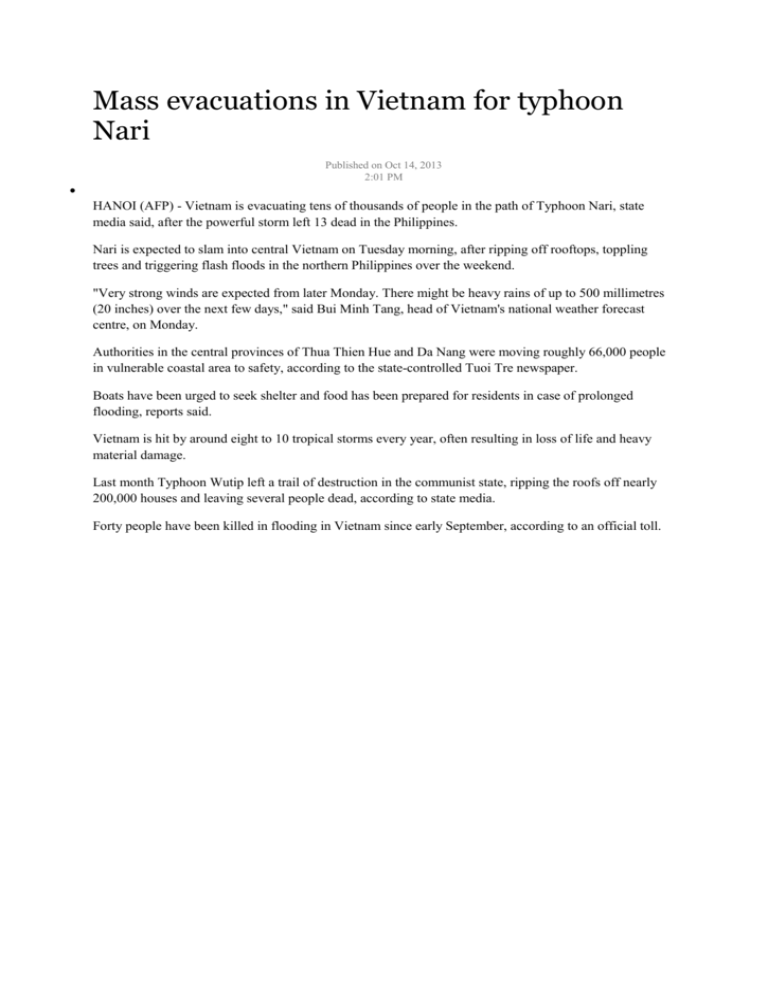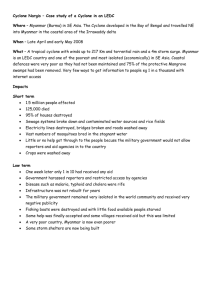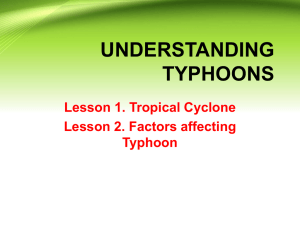Hazards and Management
advertisement

Mass evacuations in Vietnam for typhoon Nari Published on Oct 14, 2013 2:01 PM HANOI (AFP) - Vietnam is evacuating tens of thousands of people in the path of Typhoon Nari, state media said, after the powerful storm left 13 dead in the Philippines. Nari is expected to slam into central Vietnam on Tuesday morning, after ripping off rooftops, toppling trees and triggering flash floods in the northern Philippines over the weekend. "Very strong winds are expected from later Monday. There might be heavy rains of up to 500 millimetres (20 inches) over the next few days," said Bui Minh Tang, head of Vietnam's national weather forecast centre, on Monday. Authorities in the central provinces of Thua Thien Hue and Da Nang were moving roughly 66,000 people in vulnerable coastal area to safety, according to the state-controlled Tuoi Tre newspaper. Boats have been urged to seek shelter and food has been prepared for residents in case of prolonged flooding, reports said. Vietnam is hit by around eight to 10 tropical storms every year, often resulting in loss of life and heavy material damage. Last month Typhoon Wutip left a trail of destruction in the communist state, ripping the roofs off nearly 200,000 houses and leaving several people dead, according to state media. Forty people have been killed in flooding in Vietnam since early September, according to an official toll. 6 killed as 7.2-magnitude quake hits central Philippines Published on Oct 15, 2013 9:36 AM Damage to the roof and structure of the Church of San Pedro in the town Loboc, Bohol is seen after a major 7.2 magnitude earthquake struck the region on Oct 15, 2013. A major 7.2 magnitude earthquake struck near one of the Philippines key tourist hubs on Tuesday, the United States Geological Survey reported. -- PHOTO: AFP MANILA (AP) – A 7.2-magnitude earthquake struck in the central Philippines on Tuesday morning, collapsing roofs and buildings, cracking walls and roads and killing at least six people. The quake was centered 56 kilometres deep below Carmen town on Bohol Island and was felt across the region. Radio station DZMM quoted civil defence officials as saying that four people died when part of a fish port collapsed in nearby Cebu city, across the strait from Bohol. Two more people died and 19 were injured when the roof of a market in Mandaue in Cebu province collapsed, according to TV reports. People rushed out of buildings and homes, including hospitals as aftershocks continued. Photos from Cebu broadcast on TV stations showed a fallen concrete 2-storey building, and reports said two people were pulled alive, including an eight-month-old baby. Bohol Gov. Edgardo Chatto said that a church was reported damaged in the provincial capital of Tagbilaran and a part of the city hall collapsed, injuring one person. A 17th-century stone church in Loboc town, south-west of Carmen, crumbled to pieces, with nearly half of it reduced to rubble. Other old churches dating from the Spanish colonial period, which are common in the central region, also reported damage. Tuesday is a national holiday and that may have reduced casualties because schools and offices are closed. Earthquakes are common in the Philippines, which lies along the Pacific “Ring of Fire.” Cebu province, about 570 kilometers south of Manila, has a population of more than 2.6 million people. Nearby Bohol has 1.2 million people and is popular among foreigners because of its beach and island resorts. India cyclone survivors return home to destruction Published on Oct 14, 2013 12:39 PM A boy stands on the roof of his home after Cyclone Phailin hit Brahmapur town in Ganjam district in the eastern Indian state of Odisha on Oct 13, 2013. Hundreds of thousands of people who fled India's strongest cyclone in 14 years returned to their destroyed homes and businesses on Monday, as a massive relief operation kicked into gear. -- PHOTO: REUTERS GOPALPUR, India (AFP) - Hundreds of thousands of people who fled India's strongest cyclone in 14 years returned to their destroyed homes and businesses on Monday, as a massive relief operation kicked into gear. One million people were forced to seek refuge in shelters and government buildings after the terrifying cyclone struck eastern India on Saturday, killing at least 18 people and leaving a trail of destruction along the coast. Cyclone Phailin was dissipating rapidly after pounding the states of Orissa and Andhra Pradesh, bringing winds of more than 200 kilometres an hour, uprooting trees, overturning trucks, and knocking out power lines. Residents, some carrying their children and clutching bags of possessions, and who hours earlier were huddled in shelters, made their way back to their towns and villages fearing the worst. "I left everything (behind) and when I came back nothing was here," said Bhagwan, 50, who uses one name, a coconut seller from the hard-hit Odisha town of Gopalpur, as he sat on the ground in front of his destroyed shop. Some 600,000 people were left homeless in Odisha after the ferocious storm tore through thousands of villages, the state's special relief commissioner, Pradipta Kumar Mohapatra, told AFP. Many were poor fishermen and farmers living in mud and thatched dwellings, including in the worst affected area around Gopalpur, where the eye of Phailin came ashore. "I lost my house and also a small shaving shop, I lost everything," Janardan, 32, who uses one name, said from inside his tiny dwelling in Gopalpur. The cyclone collapsed the roof, leaving Janardan and his wife to begin the clean-up. Mihir Ranjan Swain, the owner of a nearby roadside eatery, was also counting the cost of the storm. "One night's chaos has cost me nearly 200,000 rupees (S$4,100) worth damages," he told AFP. "Now it will take me at least two months to recover all the losses and repair everything... At least all the people in the eatery were safe, nothing happened to them," said Swain, standing next to a giant uprooted tree at the entrance of his eatery. Seventeen people were killed in Orissa and one person further south in Andhra Pradesh, government and disaster management officials said. "The 17 deaths were due to people being crushed by falling trees, walls, roofs," R.S. Gopalan, the senior state government official coordinating relief operations in Orissa, told AFP. India's President Pranab Mukherjee expressed sadness late Sunday over those killed and urged authorities to provide speedy relief and rehabilitation to all families by the disaster. But Mukherjee also congratulated relief officials on the "high level of preparedness" which seemed to have limited the number of casualties. More than 8,000 people were killed in 1999 when a cyclone hit the same region, devastating crops and livestock. The area took years to recover. This time, the massive evacuation operation, which officials said was the biggest in Indian history, appeared to have succeeded in minimising casualties. But despite the low death toll, the cyclone left a trail of destruction and hundreds of workers from the country's National Disaster Response Force fanned out across the region, clearing away fallen trees, mangled power poles, and other debris, a statement said. Other relief workers distributed food at shelters and treated the injured, while authorities worked to restore power and other services. India's airforce deployed helicopters and transport aircraft to help supply food, water and medical supplies to those in need. In a remarkable story of survival, 18 fishermen trapped four kilometres offshore in rough seas abandoned their trawler as the cyclone approached, the Press Trust of India reported. The fishermen swam to shore and were discovered on Sunday before being taken to a local hospital near the port of Paradip in Odisha, state government officials were quoted by PTI as saying. Some 1,000 people marooned by the storm surge in a village in Andhra Pradesh were also rescued by boat, a senior disaster response official told a press conference in New Delhi. Officials in Odisha said 873,000 people moved before the cyclone made landfall on Saturday evening, while at least another 100,000 were evacuated in Andhra Pradesh. Residents were also evacuated from coastal regions of West Bengal state. High-sided trucks lying on their sides were witness to the strength of the winds on the main highway south of Gopalpur, which was littered with uprooted trees and other debris. Some of the deadliest storms in history have formed in the Bay of Bengal, including one in 1970 that killed hundreds of thousands of people in modern-day Bangladesh. Sailors rescued after ship sank in Indian cyclone; death toll at 23 Published on Oct 14, 2013 4:10 PM Damaged huts and lashed boats are pictured after Cyclone Phailin made landfall at Padampeta Village, about 200km south from the eastern Indian city of Bhubaneswar on Sunday, Oct 13, 2013. The Indian coast guard rescued 17 sailors on Monday, Oct 14, 2013, whose cargo ship sank during Cyclone Phailin, officials said, as the death toll in the storm rose to 23 people along the eastern coastline. -- PHOTO: AFP BEHRAMPUR, India (AP) - The Indian coast guard rescued 17 sailors on Monday whose cargo ship sank during Cyclone Phailin, officials said, as the death toll in the storm rose to 23 people along the eastern coastline. A mass government evacuation of nearly 1 million people spared India the widespread deaths many had feared from the powerful weekend cyclone, which destroyed hundreds of millions of dollars' worth of crops and tens of thousands of homes. The lifeboat carrying the crew of the MV Bingo was spotted by a coast guard aircraft Sunday off the coast of Odisha state, which took the brunt of the cyclone. They were brought to Calcutta on Monday. "All of them are safe now and they have been sent to a hospital for check-up," coast guard Commandant Rajendra Nath told the Press Trust of India news agency. Officials in Odisha and neighbouring Anhra Pradesh state, meanwhile, said the death toll had risen to 23 people, PTI reported. Cyclone Phailin, the strongest tropical storm to hit India in more than a decade, weakened significantly after making landfall early Saturday night, with sustained winds of up to 210 kilometres per hour, according to Indian meteorologists. The government - which had faced immense public criticism after its slow response to deadly floods and mudslides in June that killed more than 6,000 people in the northern state of Uttarakhand - moved aggressively to deal with Phailin. In part that was because of memories of a 1999 Odisha cyclone, which devastated the coastline and left at least 10,000 people dead. Nearly 1 million people were evacuated from the coast ahead of Phailin, including more than 870,000 in Odisha and more than 100,000 in neighboring Andhra Pradesh. For the people living along the coast, many of them subsistence farmers living in mud-and-thatch huts, the economic toll will be immense. Heavy rains and surging seawater destroyed more than 500,000 hectares of crops worth an estimated US$395 million (S$492 million), according to Odisha's disaster minister, S.N. Patro. The Indian Ocean is a cyclone hot spot, and 27 of the 35 deadliest storms in history - including the 1999 cyclone - have come through the Bay of Bengal and landed in either India or Bangladesh. Strong typhoon heads for Japan, nuclear plant Published on Oct 15, 2013 10:53 AM TOKYO (AFP) - A powerful typhoon was closing in on Japan on Tuesday, on a path that will take it towards the precarious Fukushima nuclear power plant. Typhoon Wipha, packing winds of up to 144 kilometres per hour near its centre, was in the Pacific south of Japan early Tuesday and moving north at 20 kilometres per hour. It was forecast to reach an area off the Tokyo metropolitan area by early Wednesday and later in the day would be off the coast of Fukushima where the crippled nuclear power plant sits. As the weather agency issued warnings of torrential rain and strong winds, the operator of the plant, Tokyo Electric Power Co. (Tepco), said it was bracing for the winds after a series of leaks of radiation-polluted water. "We are making preparations for proper management of contaminated water... We will patrol places that could have inflows of water (from the storm)," a company spokesman said. Cables and hoses are bundled together, while ground and off-shore works have been halted, he said. Earlier this month the company announced 430 litres of polluted water had spilt from a tank as workers tried to remove rainwater dumped at the plant by recent typhoons. It has admitted contaminated water may well have flowed into the sea. Japan's atomic watchdog summoned the president of Tepco for a public dressing-down for sloppy standards at the plant after the incident. The nuclear plant was badly damaged by the tsunami that hit in March 2011. Critics say it remains in a fragile state and at the mercy of extreme weather or other natural hazards.










